South Africa’s strategic position in the green metals landscape
South Africa is poised to play a significant role in the global shift towards green energy. As the demand for sustainable technologies surges, the spotlight turns to “green metals”—the critical minerals driving this new era.
The world is undergoing a major shift from fossil fuels towards a greener alternative. Green energy technologies like wind turbines, solar panels, and electric vehicles are rapidly replacing traditional fossil fuel-based systems. Mining faces growing challenges due to environmental concerns, resource competition, and societal opposition, necessitating improvements in industry practices.
A group of minerals critical for the development and functionality of these innovative technologies are aptly green metals. Building solar photovoltaic (PV) plants, wind farms, and electric vehicles (EVs) typically demands a greater quantity of minerals compared to their fossil fuel-based equivalents.
Additionally, decarbonisation efforts in the mining industry are driven by the transfer to green metallurgy and the implementation of hydrogen technologies. In addition, green primary iron production in South Africa using low-cost solar photovoltaic electricity could help global decarbonisation and boost exports, while promoting sustainable industry transformation.
The World Bank estimates that, to meet the ambitious climate change goals set by the Paris Agreement, the production of green minerals will need to increase by nearly 500%. This dramatic rise in demand presents a significant opportunity for resource-rich countries. South Africa, with its rich geological endowment, finds itself strategically positioned to capitalise on this growing demand
South African mining sector has long been dominated by gold, platinum, and coal. However, the growing demand for green metals is creating new opportunities. The country boasts significant reserves of several key green metals:
Platinum Group Metals (PGMs): South Africa is the world’s leading producer of PGMs, which include platinum, palladium, and rhodium. These metals play a crucial role in hydrogen fuel cell technology, considered a promising alternative to traditional internal combustion engines.
Manganese: Another critical component of electric vehicle (EV) batteries is manganese. South Africa holds substantial manganese reserves, positioning the country to play a significant role in the burgeoning EV market.
Vanadium: South Africa has considerable reserves of vanadium, used in redox flow batteries and steel alloys.
While not as abundant as some other countries in certain green metals, South Africa still holds notable nickel reserves, integral to lithium-ion batteries, and lithium, the heart of these batteries. Recent discoveries indicate promising potential for lithium resources. Additionally, South Africa has potential reserves of Rare Earth Elements (REEs), critical for various high-tech and green applications.




